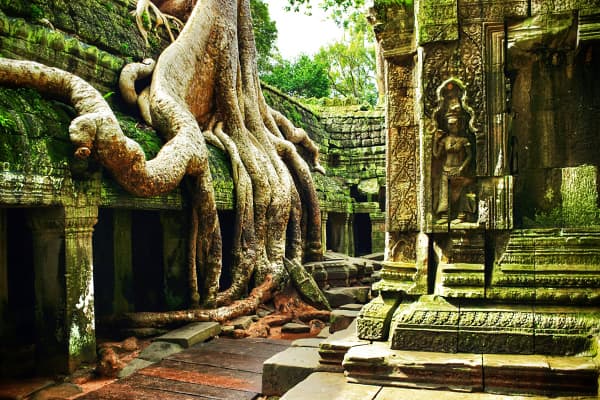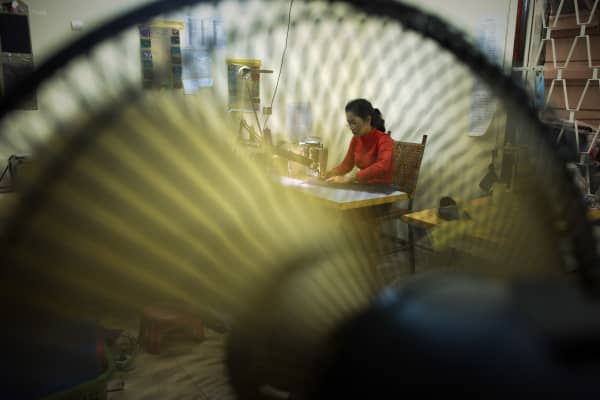By Elizabeth MacBride
On a Saturday this past fall, hundreds of people were waiting in an hourlong line to climb the staircases of Angkor Wat.
Legend has it that if you ascend to the third level of the huge 12th-century Hindu temple, you'll find the center of the universe.
The news has reached China: Most of the tourists in the courtyard and at dozens of other ancient temples in the Cambodian jungle were Chinese.
Almost unnoticed, on the coattails of China's rising economy, Cambodia has become one of the world's economic success stories, a tiny tiger in Southeast Asia.
Almost unnoticed, on the coattails of China's rising economy, Cambodia has become one of the world's economic success stories, a tiny tiger in Southeast Asia.
China's long economic growth is helping to boost Cambodia.
Tourists from China have helped push Angkor Wat to a perch as the world's top tourism destination, according to TripAdvisor.
Tourists from China have helped push Angkor Wat to a perch as the world's top tourism destination, according to TripAdvisor.
China is helping to spur Cambodia's economy in other ways, too.
It is investing billions to develop the nation's infrastructure, agriculture and health care.
At the same time, as wages rise in China's manufacturing sector, some of that business is shifting to Cambodia.
The deepening connections with Communist-controlled China worry some Cambodians, but China is seen as a better alternative than a deeper alliance with Vietnam, the landing place for communists allied with the Khmer Rouge.
Neither option seems that great to one Cambodian.
Neither option seems that great to one Cambodian.
At Angkor Wat a tour guide, noticing an American, leans in: "Please take this message back to America: Do not let communists run the world economy."

Ta Prohm, a Buddhist temple in the heart of the jungle in Angkor Wat, Cambodia, is a popular tourist destination.
The World Bank predicts Cambodia's GDP will grow more than 6.9 percent in 2018, after its economic performance ranked it sixth best in the world over the previous 10 years and pushed it into the lower-middle-income country group.

Ta Prohm, a Buddhist temple in the heart of the jungle in Angkor Wat, Cambodia, is a popular tourist destination.
The World Bank predicts Cambodia's GDP will grow more than 6.9 percent in 2018, after its economic performance ranked it sixth best in the world over the previous 10 years and pushed it into the lower-middle-income country group.
The two big drivers are tourism and garment manufacturing.
Between 2012 and 2016, tourism to Cambodia increased to more than 5 million visits from 3.5 million, according to the government of Cambodia.
Tourism contributed 12 percent, or $2.4 billion to Cambodia's economy in 2016, according to the World Travel & Tourism Council, a number that is expected to grow by 7 percent a year over the next 10 years.
Those are huge numbers for a country with a little more than 15 million people.
Those are huge numbers for a country with a little more than 15 million people.
And Cambodia's projected economic growth rate remarkably outflanks China's.
One reason may be because Cambodian companies have been able to position themselves as low-cost, reliable alternatives to Chinese factories, where wages are rising, according to Afshin Molavi, senior fellow at Johns Hopkins University Paul H. Nitze School of Advanced International Studies.
"Cambodia is becoming part of an interesting Asian strategy for any of the global multinationals," said Molavi, also co-director of think tank Emerge85.
"We're seeing [the growth] in real estate. There is a lot of construction going on. When I look at the Phnom Penh Post, I see lots of stories about the middle class buying properties."
Cambodia still lives under a shadow, however.
Cambodia still lives under a shadow, however.
Memories of the genocide from 1975–79 still color the world's perception of Cambodia, though they are also driving the country's young people to overcome that perception.
The authoritarian government hasn't helped: It has been cracking down on civil society, dissolving the largest opposition party in November.
That makes things tricky for big multinationals, like Walmart.
That makes things tricky for big multinationals, like Walmart.
A spokeswoman for the company said it sources apparel, footwear, home goods and accessories in Cambodia.
"We recently discussed with the government potential to increase our sourcing further, as well as the importance and our expectations of the protection of civil rights in the countries from which we source. We respectfully asked the Cambodian government to continue to improve working conditions for Cambodian factory workers and treat civil society with fairness, in accordance with international standards and norms."
There remains a serious issue with income inequality in the Asian nation.
There remains a serious issue with income inequality in the Asian nation.
About 13.5 percent of Cambodia's population lives on less than $2 a day, according to the World Bank.
That is down from 47.8 percent in 2007, and income levels have barely risen for many people. Cambodia stagnated for the latter part of the 20th century partly because of internal conflict and the lack of infrastructure in rural areas.
There are still unexploded land mines left over from bombing during the Vietnam War.
In a sign of Cambodia's increasing importance in Southeast Asia, the Trump administration aimed to cut U.S. State Department funding of $2 million for land mine clearance — and then reinstated it after an outcry.
The China factor
Many of the tourists visiting Cambodia are Chinese, and they are stoking tourism growth.
The China factor
Many of the tourists visiting Cambodia are Chinese, and they are stoking tourism growth.
Even though only about 6 percent of Chinese people have a passport, China has become the world's largest outbound tourist market, with more than 135 million departures a year — and Angkor Wat is an easy two- or three-hour flight from many cities in China.
Signs of the tourism boom abound in Siem Reap, the town near many of the hundreds of temples constructed during the Khmer Empire, which once stretched from Myanmar to Vietnam.
Signs of the tourism boom abound in Siem Reap, the town near many of the hundreds of temples constructed during the Khmer Empire, which once stretched from Myanmar to Vietnam.
In 2016, Cambodia-based Sokha Hotels & Resorts opened a 776-bed resort, and a drive down the highway leading to Angkor Wat revealed two more hotels under construction.
Most online platforms report hundreds of hotels in the town (TripAdvisor lists more than 300), though concrete numbers are hard to come by.
Angkor Wat hit the tourist map in the early 1990s, when it became a World Heritage Site — but it is already the world's top-rated tourism destination, based on a combination of the number of reviews and what they say, according to TripAdvisor.
Angkor Wat hit the tourist map in the early 1990s, when it became a World Heritage Site — but it is already the world's top-rated tourism destination, based on a combination of the number of reviews and what they say, according to TripAdvisor.
Many Americans are only vaguely aware of it, but it beats out the Great Wall and the Taj Mahal. Visitors call it "majestic," "memorable" and "like nothing I've ever seen."
A key outsourcing hub
Cambodia's boom in garment manufacturing has also been driven by changes in China.
A key outsourcing hub
Cambodia's boom in garment manufacturing has also been driven by changes in China.
As wages have risen in China over the last decade, Cambodian companies have positioned themselves as low-cost, reliable manufacturers, said Johns Hopkins Molavi.
"I don't see anything to show that it's going to slow in 2018," he said.
"When you have that kind of manufacturing growth, what also happens is that you have rapid urbanization and growing middle classes at the lower end. People buy motorbikes and scooters, Kit Kat bars and Coca-Cola."
Village markets show multinationals adapting their strategies for markets like Cambodia, with inexpensive, single-serve boxes of detergent and shampoo, for instance.

A factory in Phnom Penh. Cambodian companies have positioned themselves as low-cost, reliable manufacturers.
Cambodia has a couple of other things going for it: Angelina Jolie and a generation of young people determined to rebuild their country from the poverty of previous generations and heal the scars of the genocide.
The other spur to Cambodian tourism has a much darker cast.

A factory in Phnom Penh. Cambodian companies have positioned themselves as low-cost, reliable manufacturers.
Cambodia has a couple of other things going for it: Angelina Jolie and a generation of young people determined to rebuild their country from the poverty of previous generations and heal the scars of the genocide.
The other spur to Cambodian tourism has a much darker cast.
A few hundred thousand people visit the Killing Fields every year; there is another site open to the public in Phnom Penh, a former school where victims of the genocide were tortured before being taken to the Killing Fields.
The communist Khmer Rouge took control of the country under a dictator, Pol Pot.
An estimated 2 million Cambodians, many of them the educated professionals of Cambodian society, were killed.
In 2001 action-adventure film Lara Croft: Tomb Raider, starring Angelina Jolie, was shot in Cambodia, and Jolie adopted one of her children, Maddox, from an orphanage in the country.
In 2001 action-adventure film Lara Croft: Tomb Raider, starring Angelina Jolie, was shot in Cambodia, and Jolie adopted one of her children, Maddox, from an orphanage in the country.
She has become an advocate for Cambodians.
Last fall she released First They Killed My Father: A Daughter of Cambodia Remembers, about the genocide, on Netflix.
After an event for rising Cambodian leaders at the private school Liger Leadership Academy, one of the Cambodian stars of Jolie's film said working on it inspired her to start talking to her grandmother, who lost her husband in the genocide, about her experience.
After an event for rising Cambodian leaders at the private school Liger Leadership Academy, one of the Cambodian stars of Jolie's film said working on it inspired her to start talking to her grandmother, who lost her husband in the genocide, about her experience.
"She's open to talking about it more and more."
Sreyneang Oun plays a daughter of the family in the film — and has since developed a friendship with Jolie's family.
For years, said Caroline Bell, leader teacher at the school, the genocide wasn't spoken about in Cambodia.
Sreyneang Oun plays a daughter of the family in the film — and has since developed a friendship with Jolie's family.
For years, said Caroline Bell, leader teacher at the school, the genocide wasn't spoken about in Cambodia.
Now it's become something young Cambodians feel they can explain to the world.
"We try to get them to see there's always gray area between victim and perpetrator," said Bell. "Globally, it's one of the two things Cambodia is known for."
Aucun commentaire:
Enregistrer un commentaire